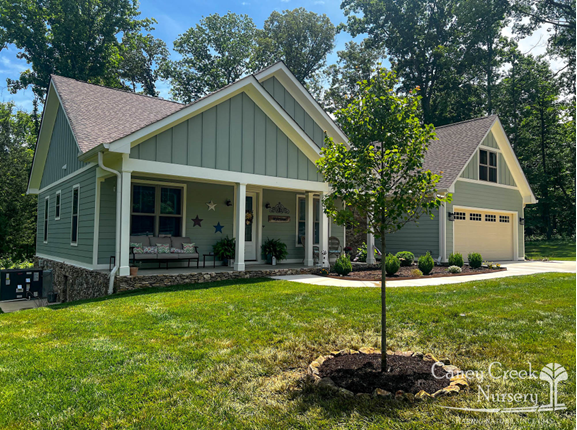As temperatures climb in Zone 7, keeping your landscape thriving starts at the root level—literally. At Caney Creek Nursery, our passion lies in helping homeowners cultivate beautiful, enduring landscapes that thrive throughout the warmest months. Whether you’re caring for ornamental shrubs, fruit trees, or a vibrant veggie patch, knowing how to water wisely is the key to long-term success.
With over two decades of experience serving homeowners across Zone 7a and 7b, our landscape experts have created this Watering guide for Zone 7 to help you make informed, practical decisions to keep your yard green and your garden happy. From calculating rootball hydration to installing the right irrigation system, we’ve got you covered with tried-and-true strategies rooted in horticultural science.
Understanding Rootball Watering: Science Meets Soil
Every healthy plant starts with its roots. And in summer, the roots are where your watering efforts should focus. The most accurate way to determine how much water your plant needs is to understand its rootball size. The gallon size of the rootball corresponds directly to the number of gallons of water it requires.
In simple terms:
1 gallon rootball = 1 gallon of water per watering.
That means if you’ve planted, let’s say, a 35-gallon tree, you’re looking at 35 gallons of water per session. It’s not a rough estimate. It’s a horticulturally sound rule of thumb that ensures your plants get what they need to establish themselves without becoming waterlogged or stressed.
Initial Watering Timeline
If your plant installation was handled by Caney Creek Nursery, we take care of the first deep watering. After that, your job begins. For the first 4 to 5 weeks, water your plants once per week, using the rootball size to guide how much water is needed. If a drought persists or we’re facing prolonged high temperatures, continue watering weekly until conditions normalize.
Watering Tips for Deep Hydration
- Target the base of the rootball directly, not the leaves or surrounding mulch.
- Use a slow, steady flow of water. Fast flows tend to run off instead of soaking in.
- If you’re unsure how much your hose delivers, try this: Time how long it takes to fill a 5-gallon bucket. If it takes, for example, 2 minutes, then you’re delivering 2.5 gallons per minute. Adjust accordingly to match your plant’s needs.
Why This Matters
Proper watering in these early stages is what sets your plant up for a successful life in your garden. Think of it like the foundation of a home or the firewood that fuels an outdoor fireplace. Without it, everything else is at risk. Similarly, healthy root systems are critical to the transformation of your space into a lush and lasting outdoor living environment.
No More Guesswork: Use a Water Meter
Even experienced gardeners can’t always tell what’s going on below the soil’s surface. That’s where a water meter, also known as a soil moisture meter, becomes your best friend.
A water meter measures soil moisture on a scale from 1 to 10, helping you determine exactly how hydrated your soil is. Readings between 1 and 3 indicate dry conditions, while 4 to 6 signals that the soil is moderately moist. A reading between 7 and 10 means the soil is wet.
For most plants, especially during the summer months in Zone 7, the ideal moisture level is around 7. It’s moist enough to encourage healthy root development without risking overwatering.
How to Use It Correctly
To use a water meter correctly, begin by inserting the probe directly into the rootball. This ensures you’re measuring moisture where it matters most. On larger trees or shrubs, it’s important to test multiple spots, as moisture levels can vary throughout the root zone.
Once inserted, give the needle a few seconds to stabilize before reading the result. After watering, use the meter again to confirm that moisture has reached the appropriate level, helping you fine-tune your irrigation efforts for the best results.
Still not sure? Here’s a short video tutorial on how to use a soil moisture meter. Soil moisture meters are readily available online or at local garden supply centers. They’re an easy investment with long-term benefits!
Smart Irrigation Solutions: Soaker Hoses & Watering Emitters
Hand watering can be fun but it’s not always realistic. For larger landscapes or busy homeowners managing an outdoor living environment, a smart irrigation system makes staying consistent far easier.
Two of the most effective solutions are:
1. Soaker Hose Systems
Think of soaker hoses as slow, steady deliverers of hydration. Their porous tubing allows water to seep directly into the soil, soaking plant roots efficiently while reducing evaporation and waste. These systems shine in pet-friendly garden beds, around shrubs, and even in vegetable gardens where water consistency is key.
Gardeners love them for all the right reasons: They deliver water exactly where it’s needed (at the root zone), keep foliage dry, help to prevent mildew and leaf disease and pair easily with timers to maintain consistent schedules. Here are some tips for maximum effectiveness:
- Loop the hose around larger plants or trees to fully saturate the rootball
- Lightly cover hoses with mulch to preserve moisture and hide tubing
- Water early in the morning to reduce water loss from heat and sun
2. Drip Irrigation with Watering Emitters
For tailored care, especially around specimen trees, foundation plantings, or areas with hardscape design, watering emitters (also known as drip emitters or micro-irrigation) are ideal. These systems let you control how much water each plant receives based on its size and specific needs.
Emitters are designed to deliver water slowly, typically at rates like 0.5, 1, or 2 gallons per hour. You can scale the output by using multiple emitters per plant depending on its rootball size.
Here are some suggestions to keep in mind:
- Use the gallon-to-gallon rule; for example, a 2-gallon plant should get two 1-gallon/hour emitters
- Place emitters close to the base of the plant, not on the foliage or mulch
- Regularly inspect your system for blockages or leaksThese systems are particularly helpful in yards with walkways, patios, or intricate landscape designs. You can maintain moisture without disrupting the extraordinary aesthetic created by our team of experts.
Keep It All Growing: Lawns and Veggie Beds Matter Too
Your watering strategy shouldn’t end at shrubs and ornamentals. Lawns and gardens, often the heart of any outdoor living space, require just as much attention to keep your landscape balanced and productive.
For a Healthy Lawn:
- Aim for 1 to 1.5 inches of water per week
- Use a simple “tuna can test” to measure your sprinkler output evenly
- Water deeply and infrequently to encourage strong root growthA lush, green lawn not only enhances curb appeal but also offers space for play, pets, and outdoor living entertainment.
For Your Vegetable Garden:
- Most veggies need at least 1 inch of water weekly, sometimes more in extreme heat
- Crops like cucumbers, squash, and tomatoes tend to be thirstier
- Avoid overhead watering that splashes soil onto leaves, which can invite disease
- Apply mulch to help retain soil moisture and suppress weedsWhether you’re harvesting herbs for dinner or tending to a garden that feeds the whole family, summer watering is the secret behind those vibrant colors and juicy crops.
Design Integration That Works With Nature
At Caney Creek Nursery, we believe great landscapes do more than look good. They function beautifully. That includes proper water management, thoughtful landscape design, and systems that support both aesthetics and longevity.
When planning your next installation or garden upgrade, consider how watering will fit into the bigger picture. Whether you’re investing in custom walkways, elevated beds, or adding a showstopping outdoor fireplace, your watering system should be part of the plan from the start. And as the sun sets, well-placed landscape lighting and outdoor lighting can highlight your hydrated, thriving plants, turning your yard into a glowing, welcoming retreat.
Let Your Landscape Thrive All Summer
Water is the invisible lifeline of your garden. With a solid understanding of rootball needs, the help of a reliable water meter, and the support of smart irrigation systems, you’ll give your landscape every chance to flourish, even during the hottest months in Zone 7.
Let our team of experts help you create an extraordinary outdoor space where function meets beauty, season after season. If you’re ready to explore more about landscape lighting, garden upgrades, or sustainable watering solutions, contact us today at (703) 627-5824 to schedule a consultation.
We’re here to support your journey from soil to splendor.





